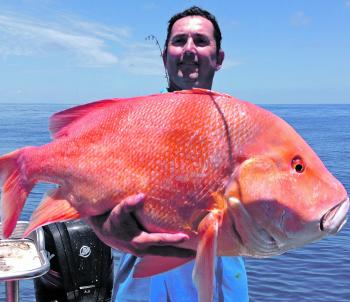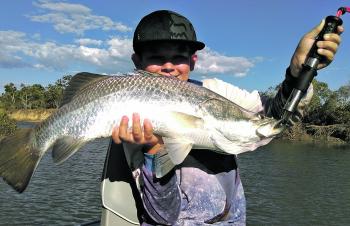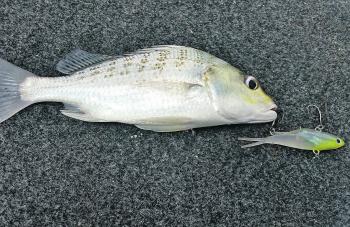Winter is here at last after the warmest first six months of the year anyone can remember. Winter means the Bs: big bream, blue salmon, black jew, buck crabs, baitfish and even barramundi.
‘Horse bream,’ ‘snodgers’ or just huge bream are appearing all around the area. The local headlands and rock bars around the mouths of the local creeks are firing. Wreck Point, Stevensons Rocks, Bluff Rocks and Rosslyn Bay Harbour are spots you can walk to that can almost guarantee a feed of bream.
Bream are considered by some to be a poor cousin to barra, jacks and threadfin salmon found in our area, but they are a fish available to everyone without having to spend a fortune on equipment. Most of us have done our time with bream and learned much of what we needed to progress our fishing careers on the back of the bream. They will take a wide variety of baits or lures and make a tasty feed when cooked fresh.
Blue salmon have featured again in a few captures recently after a quiet spell. In the cooler months they school up and hit plenty of places along the coast. Ritamada, Coorooman Creek, Ross Creek and Farnborough Beach are known for fine catches of blues. There have been some stonker muddies about in the last week or two. The rain events have sparked up the creeks, bringing crab and prawn catches up considerably.
Everyone wants to catch a metre barramundi. As much as I have tried to remain neutral on the net free zones, I can’t refute the difference they have made in the very short time they have been in place. I have seen more quality barra in the last 12 months than ever before. It’s becoming regular to see someone holding up their first big barra and the capture of a lifetime.
Most of these fish are released to fight and contribute to the system’s growth. We have also benefited from the floods and the overflow of Awoonga adding hundreds of massive fish into the region that will be breeders in coming seasons. I have said this in the past: we have the potential to be the Queensland barramundi capital and rank up there with any system in the world.
The floods came right in the middle of a barra boom and dispersed many of the fish that had congregated in the town area. Catches are coming from all around the Capricorn Coast and every local system. The drop in temperatures might slow them a little, but they still have to eat. This means that your lure or bait will have to be placed right near the fish and they may bite for shorter periods. So far the fish keep turning up. Live baits and lures have been working equally well.
After a late flood season, which turned the Fitzroy River and Keppel Bay completely around, the benefits of the flood time are coming on. The bay and the estuaries are clearing up and are producing some fantastic fishing. All the species in the bay and around the fringes have benefited from the extra feed flushed down by the floods. As per usual, grunter, largemouth and smallmouth nannygai are the first fish to move into the bay in numbers to feast on the additional prawns, crabs and other morsels flushed out to them.
Grunter are showing up in very good numbers at places like the Pinnacles, the Rama, Manifold, the Barge, Findlays, Quartz and various other little spots quite close to Yeppoon. The optimum times are a few days either side of the full or new moons. Many times they will be ready to chew when the conditions are settled. Most of these spots hold big black jew at the same time and usually we set one large bait and one small bait each. This goes to plan except when a black jew grabs your light gear instead of the heavy rig. These guys show no mercy in shallow water and will test your equipment to the max.
Both grunter and black jew will take lures if presented the right way. Estuary grunter love small chrome or gold metal vibes and many times recently they have out-fished the baits. Offshore they’re a little less fussy and will take anything from a Squid Vicious to a prong and various other plastic styles. I like to use vibes in semi-natural colours for the fish up to 20m deep. Grunter and black jew will take the same bait. As long as it’s fresh there is a good chance of a decent catch. Squid, pilchards, flesh strips and prawns are the most favoured baits.
We cut pillies into thirds with a small piece of squid on each hook so that the broken up pilly berleys the immediate area and the squid hangs in long enough for another grunter to grab if the first fish doesn’t hook up. For grunter, we usually have a running ball sinker right down to a 4/0 octopus or circle hook. Black jew baits are quite a bit larger than grunter baits. The favourite method is a whole pilly or a whole squid on each hook. Some anglers like to use a squid and pilly cocktail, which works very well too.
For black jew, I prefer a paternoster or ‘snapper rig,’ as most people call it. I have the minimum size snapper lead required to hold the bait at the bottom and two droppers coming of the leader at approximately 300mm and 600mm with 8/0 or 9/0 circle hooks. Black jew fiddle with the bait sometimes and fishers who are prone to strike at a nibble can turn the fish off quickly in shallow water. These are the advantages of using circle hooks: the fish is hooked in the corner of the mouth for easy release and the fish hooks itself. When black jew and grunter are on the chew it can be very easy to get greedy and slay too many fish. The fish caught in the shallow water are easily released but the deeper water fish are prone to barotrauma.
Reefies and pelagics are both going strong at present around the islands and the wide areas. Some of the recent catches of red emperor, largemouth nannies and coral trout have been epic. We have stopped going to any grounds we have fished before and the results are starting to mount. Lots of times Joe Average will hit the same old spots every time they go out. Catches decrease and they start complaining that the fishing is terrible. To have consistency you need to spend as much time searching as you do fishing.
Watch your sounder and investigate changes or lumps that you see. On a trip last month, we found ten new spots, fished five of them for a drop each and landed half a dozen trophy-sized red emperor. The skipper caught his first wahoo, a 10kg spotted mackerel and some serious redthroat emperor. We could have been greedy and stayed longer at each spot if we really needed the fish. We left each spot while the fish were chewing. This gives us some solid locations to try in the future while taking home a great feed.
Spanish mackerel have slowed from the bigger schools to the residents. This means that the average catches will be a bit fewer and the fish are usually slimmer. Bait schools are starting to come around the islands, particularly rainbow runners and bonito. When these schools come through it is time to score some bait for the future. Fish around them as the predators are usually in attendance.
Reads: 2562
Mark Simkins with his PB red emperor caught on Reel Naughti.

Mark Sheen nailed this fine barra in the town reaches of the Fitzroy.

Riley Bust scored this great barra locally.

Even small grunter will take a large vibe when it’s put right down into the school.




